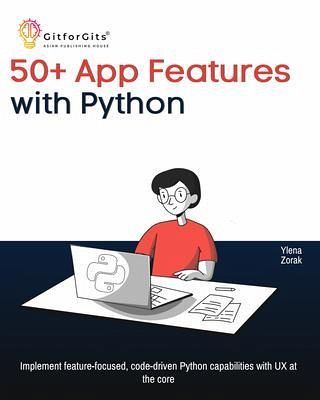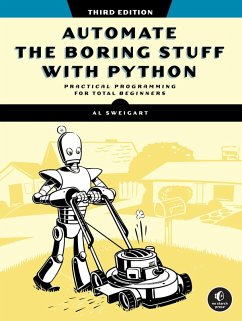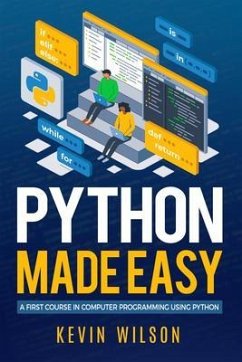
50+ App Features with Python (eBook, ePUB)
Implement feature-focused, code-driven Python capabilities with UX at the core

PAYBACK Punkte
15 °P sammeln!
"50+ App Features with Python" is for developers who want to build real solutions, not just read theory. The book will help you work with robust, feature-centric code that brings today's most popular app capabilities to life. This includes core data management and authentication, rich user experiences, notification systems, security layers, deployment, and modern testing pipelines.To get started, you'll set up your development environment and dive right into building APIs with FastAPI, making sure your data is validated with Pydantic, and checking out database management using SQLAlchemy. You'...
"50+ App Features with Python" is for developers who want to build real solutions, not just read theory. The book will help you work with robust, feature-centric code that brings today's most popular app capabilities to life. This includes core data management and authentication, rich user experiences, notification systems, security layers, deployment, and modern testing pipelines.
To get started, you'll set up your development environment and dive right into building APIs with FastAPI, making sure your data is validated with Pydantic, and checking out database management using SQLAlchemy. You'll get access to advanced features like CRUD endpoints, pagination, filtering, and bulk import/export without having to go back and relearn the basics. We'll go over how to set up authentication and authorization flows, including role-based access and two-factor authentication, in the context of secure, maintainable code. It then goes on to user-centric enhancements, showing how to implement drag-and-drop uploads, dynamic forms, custom error pages, and adaptive themes. Basically, it brings real interactivity to your projects. When it comes to hands-on experience, you'll be using real integrations like Celery for background tasks, Twilio for SMS, OAuth2 for social login, and webhook handling for event-driven workflows. Once it's time to deploy, you'll learn about containerization with Docker, orchestration with Kubernetes, log aggregation, and operational monitoring. Security and compliance are a big deal here, with heavy coverage of CSRF, CORS, encryption, CSP headers, and audit logging. The last few chapters are all about testing and CI/CD. You'll learn about unit and integration testing with Pytest, pipeline automation with GitHub Actions, and coverage reporting.
Key Features
Set up Python environments with reproducible workflows.
Use FastAPI, Pydantic, and SQLAlchemy to build RESTful APIs.
Implement CRUD, pagination, filtering, and scalable API endpoints.
Develop authentication, password resets, roles, and two-factor security.
Create interactive forms, uploads, error pages, and theme toggles.
Integrate email, SMS, social logins, and webhook handling.
Use Docker Compose and Kubernetes manifests to make it scalable.
Secure your apps with CSRF, CORS, AES-GCM, and CSP headers.
Monitor user actions with tamper-proof, timestamped audit trails.
Use Pytest and GitHub Actions to automate testing and coverage.
Table of Content
Environment Setup & Core Data Management
Authentication & Authorization
User Experience Enhancements
Notifications & Integrations
Performance & Scalability
Data Processing Utilities
Deployment & Operations
Security & Compliance
Testing & CI/CD
To get started, you'll set up your development environment and dive right into building APIs with FastAPI, making sure your data is validated with Pydantic, and checking out database management using SQLAlchemy. You'll get access to advanced features like CRUD endpoints, pagination, filtering, and bulk import/export without having to go back and relearn the basics. We'll go over how to set up authentication and authorization flows, including role-based access and two-factor authentication, in the context of secure, maintainable code. It then goes on to user-centric enhancements, showing how to implement drag-and-drop uploads, dynamic forms, custom error pages, and adaptive themes. Basically, it brings real interactivity to your projects. When it comes to hands-on experience, you'll be using real integrations like Celery for background tasks, Twilio for SMS, OAuth2 for social login, and webhook handling for event-driven workflows. Once it's time to deploy, you'll learn about containerization with Docker, orchestration with Kubernetes, log aggregation, and operational monitoring. Security and compliance are a big deal here, with heavy coverage of CSRF, CORS, encryption, CSP headers, and audit logging. The last few chapters are all about testing and CI/CD. You'll learn about unit and integration testing with Pytest, pipeline automation with GitHub Actions, and coverage reporting.
Key Features
Set up Python environments with reproducible workflows.
Use FastAPI, Pydantic, and SQLAlchemy to build RESTful APIs.
Implement CRUD, pagination, filtering, and scalable API endpoints.
Develop authentication, password resets, roles, and two-factor security.
Create interactive forms, uploads, error pages, and theme toggles.
Integrate email, SMS, social logins, and webhook handling.
Use Docker Compose and Kubernetes manifests to make it scalable.
Secure your apps with CSRF, CORS, AES-GCM, and CSP headers.
Monitor user actions with tamper-proof, timestamped audit trails.
Use Pytest and GitHub Actions to automate testing and coverage.
Table of Content
Environment Setup & Core Data Management
Authentication & Authorization
User Experience Enhancements
Notifications & Integrations
Performance & Scalability
Data Processing Utilities
Deployment & Operations
Security & Compliance
Testing & CI/CD
Dieser Download kann aus rechtlichen Gründen nur mit Rechnungsadresse in A, D ausgeliefert werden.













